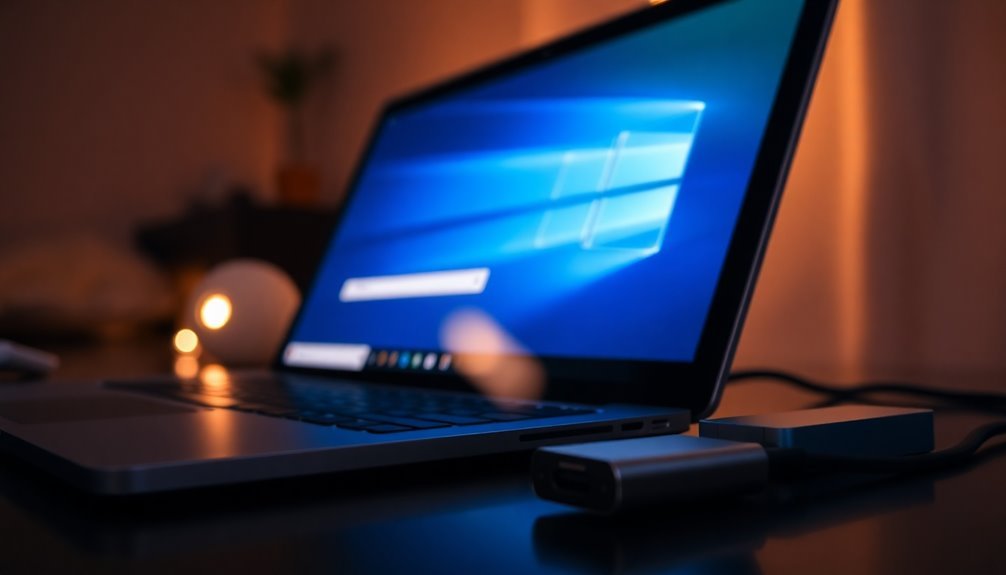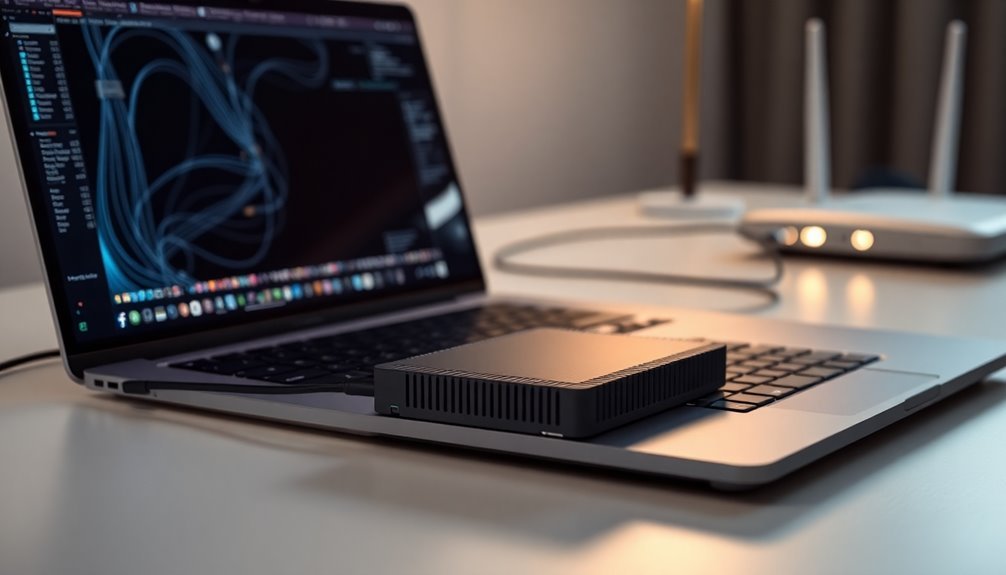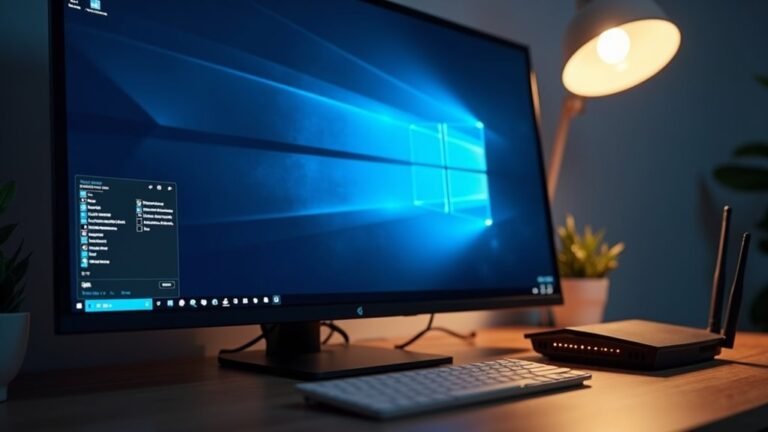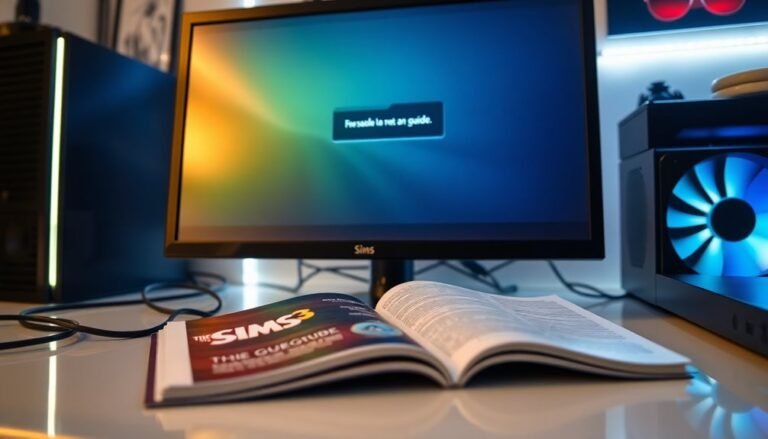Windows 11 Slow Copy Speed: Fix File Transfer Speed Issues

To fix slow copy speeds in Windows 11, first update all USB, storage, and network drivers. Switching to USB 3.0 ports and using high-quality cables can significantly improve transfer speeds.
Consider using SSDs instead of HDDs for faster performance. For network transfers, use wired Ethernet and ensure NAS or SMB settings match your hardware.
Disable real-time antivirus and close unnecessary background apps to free up resources. Try using robust tools like Robocopy with multi-threading for better file transfer management.
If you want more advanced tips and preventative strategies, you’ll find them just ahead.
Common Causes of Slow File Transfers in Windows 11

Common Causes of Slow File Transfers in Windows 11 and How to Fix Them
If you experience slow file transfers in Windows 11, several factors could be affecting your transfer speeds. Understanding these common causes can help you optimize performance and troubleshoot effectively.
- SMB Protocol Limitations: Windows 11 uses the SMB protocol for file sharing. Recent updates may add encryption or signing overhead, which can slow down transfers, especially on CPUs with fewer cores.
- Network Issues: Packet loss, TCP congestion, or unstable Wi-Fi connections can significantly reduce file transfer speeds. Using a wired Ethernet connection often improves stability and throughput.
- USB Port and Cable Problems: Transferring files via USB 2.0 ports or using damaged or low-quality cables limits speeds compared to USB 3.x ports and certified cables. Always connect devices to the fastest available USB port.
- Outdated Drivers and Hardware Bottlenecks: Ensure your USB controller drivers are up to date. Additionally, transferring files to or from slower storage devices like HDDs instead of SSDs can bottleneck performance.
- Software Overhead: Features such as Remote Differential Compression (RDC) and real-time antivirus scanning can add processing overhead, slowing down file transfers. Temporarily disabling antivirus or RDC may help identify if they contribute to delays. Sometimes, antivirus software may interfere by scanning files during transfer, adding extra time to the process.
- Permissions and Background Processes: Incorrect file permissions or high CPU usage from background applications can cause transfer delays. Check system resource usage and adjust permissions as needed.
- Environmental Factors: Large numbers of small files or incompatible storage formats may affect transfer efficiency. Compressing files or converting storage formats can improve speeds.
By addressing these common causes of slow file transfers in Windows 11, you can enhance your file sharing experience and achieve faster, more reliable transfers.
For optimal results, regularly update your system, drivers, and hardware, and consider network improvements where applicable.
Symptoms and Signs of File Copy Speed Problems
Even though modern systems are designed for fast file transfers, many Windows 11 users experience slow file copy speeds that can turn quick transfers into long waits. If you notice your file copy operations taking hours instead of minutes, fluctuating transfer rates, or speeds dropping below 1 MB/s, especially after recent Windows updates, you may be facing common performance issues affecting file copying. A key cause of these problems can be traced to recent SMB protocol changes introduced by Windows 11 updates, which have been documented by Microsoft as causing file transfer slowdowns.
Key signs of slow file copy speeds include:
- Transfer progress bars freezing or showing 0 KB/s intermittently during file copy.
- Copying many small files taking significantly longer than copying single large files.
- Real-time antivirus scans or encryption software causing inconsistent transfer speeds.
- Noticeable speed drops following Windows 11 updates or changes to the SMB protocol.
- Network speed tests (e.g., iperf) indicating high bandwidth, but actual file copies remain slow.
- Ethernet transfers being fast, but transfers through routers or network-attached storage (NAS) showing severe slowdowns.
These symptoms usually indicate protocol-level bottlenecks or operating system issues rather than hardware defects.
Hardware Checks to Boost Transfer Performance
Boost Your File Transfer Speed with Essential Hardware Checks
Before exploring advanced software solutions, start by optimizing your hardware setup to eliminate common transfer speed bottlenecks. Ensure you’re using high-speed ports such as USB 3.0, USB 3.1, USB 4.0, or Thunderbolt for external data transfers—these interfaces can deliver transfer speeds up to 40 Gbps, compared to the limited 480 Mbps of USB 2.0.
Identify your port versions by checking the port color (blue typically indicates USB 3.x) or by accessing Device Manager under “Universal Serial Bus Controllers” on Windows.
Use certified, high-quality cables that match your device’s speed rating to avoid throttling performance due to older or damaged cables. When it comes to storage devices, SSDs—especially NVMe SSDs—offer significantly faster transfer speeds compared to traditional HDDs.
For optimal results, use SSDs for both the source and destination drives. Run SMART diagnostics to assess drive health and detect any defects or bad sectors that could slow down file transfers.
Additionally, verify that your BIOS/UEFI settings have AHCI mode enabled for SSDs and support for high-speed USB ports activated. Upgrading outdated drives, cables, and ensuring proper port connections can drastically improve copy speeds, laying a strong foundation before applying software tweaks to further enhance transfer performance.
Software Fixes and Configuration Tweaks
Boost File Transfer Speeds in Windows 11 with These Proven Software Fixes and Configuration Tweaks
If your hardware isn’t causing slow file transfers in Windows 11, optimize your system with effective software fixes and configuration tweaks to significantly speed up the process.
Start by using specialized file copy tools like FastCopy, TeraCopy, or UltraFastCopy. These advanced utilities outperform the default File Explorer by utilizing multi-threading and direct I/O, making them ideal for transferring large or complex files quickly.
Don’t forget to run Windows’ built-in Disk Cleanup tool and defragment your hard drives (HDDs) regularly. This helps optimize file structure and frees up system resources for faster data handling.
For power users, command-line tools like robocopy offer powerful options such as the `/MT` multi-threading switch and `/J` unbuffered I/O mode, which can drastically increase file transfer throughput during heavy operations.
Keeping your system drivers, especially USB and storage drivers, up to date is essential to ensure smooth communication between devices and prevent bottlenecks.
Additionally, adjusting your power settings to avoid CPU and disk throttling during large file transfers can improve performance.
To further maximize speed, disable unnecessary background applications and startup services that compete for CPU and disk usage.
Key tips to accelerate file transfers in Windows 11:
- Use FastCopy, TeraCopy, or UltraFastCopy for faster and more efficient file copying
- Run Disk Cleanup and defragment your HDDs regularly for optimized file structure
- Utilize robocopy with `/MT` and `/J` switches for high-speed command-line transfers
- Update USB and storage device drivers to enhance compatibility and speed
- Disable background apps and optimize startup to reduce resource competition
Implementing these software tweaks and configuration adjustments can dramatically improve your Windows 11 file transfer speeds and overall system responsiveness.
Addressing Network and NAS Transfer Issues

Improve File Transfer Speeds Between Windows 11 and NAS: Top Network Tips
Are you facing slow file transfers between your Windows 11 PC and your NAS device? Optimizing your network configuration and ensuring protocol compatibility can significantly boost transfer speeds.
Start by confirming that both your NAS and Windows 11 support SMB 2.0 or SMB 3.0 protocols, as outdated SMB 1.0 is often disabled and can drastically reduce performance. Make sure to update your NAS firmware and Windows network drivers to the latest versions to enhance compatibility and stability.
Next, set your network adapter to “Full Duplex” mode at 1.0 Gbps to avoid auto-negotiation bottlenecks that can slow down your connection. Disable any network interface card (NIC) power-saving features in Windows Device Manager to prevent your adapter from entering sleep states during transfers.
Synchronize the MTU (Maximum Transmission Unit) settings on both Windows 11 and your NAS to prevent packet fragmentation, which can degrade throughput.
For advanced optimization, open the Registry Editor and verify that the Tcp1323Opts setting enables proper TCP window scaling. If you continue to experience slow transfers, consider disabling Windows Auto-Tuning to improve network performance.
Whenever possible, use a direct wired Ethernet connection instead of wireless to maximize speed and reliability.
Finally, monitor your network utilization via Task Manager to ensure Windows isn’t limiting bandwidth during file transfers. By following these essential network and system tweaks, you can achieve faster and more reliable file transfers between your Windows 11 PC and NAS device.
Resolving USB Transfer Bottlenecks
How to Fix USB Transfer Bottlenecks in Windows 11 for Faster Speeds
If you’re experiencing slow USB transfer speeds on your Windows 11 PC, hardware limitations and configuration issues are often the culprits. While network optimizations can improve NAS transfers, boosting USB data transfer rates requires targeted fixes.
To eliminate USB transfer bottlenecks and achieve maximum throughput, follow these expert tips:
1. Use USB 3.0 or Higher Ports and Certified Cables
Always connect your devices to USB 3.x ports rather than USB 2.0, as older ports limit speeds drastically. Use high-quality, certified USB cables and avoid unsupported USB hubs or extensions that can degrade performance.
2. Enable USB 3.0/3.1 Support in BIOS/UEFI
Access your BIOS or UEFI settings to ensure USB 3.0 or USB 3.1 functionality is enabled. Disabled settings here can throttle your USB transfer rates.
3. Update and Reinstall USB Drivers via Device Manager
Open Device Manager to verify that USB controller drivers are correctly installed and up to date. If necessary, reinstall or update drivers to maintain optimal USB performance on Windows 11.
4. Disable USB Selective Suspend in Power Settings
USB selective suspend can cause intermittent slowdowns. Disable this feature in the Power Options menu to prevent Windows from throttling USB data transfers.
5. Update External Drive Firmware and Use Manufacturer Tools
Check for firmware updates for your external drives. Using manufacturer-specific tools can improve compatibility and enhance USB transfer speeds.
By following these Windows 11 USB transfer optimization steps, you can effectively resolve common bottlenecks and enjoy faster data transfers.
For more tips on improving USB performance and troubleshooting USB issues, stay tuned to our tech guides.
Optimizing Large File Transfers for Best Results
Optimize Large File Transfers in Windows 11 for Maximum Speed and Reliability
While Windows 11 File Explorer provides basic file copying, to achieve faster and more reliable large file transfers, using specialized tools and system tweaks is essential.
Boost your transfer speeds by using Robocopy with the `/J` switch for unbuffered I/O and `/MT` for multi-threading—this method significantly outperforms File Explorer when moving files larger than 1 GB.
For network file transfers, enable SMB Compression on compressible file types like .vhd and .iso, but avoid it for already compressed formats such as .zip and .mp4 to save time.
Ensure your drives are SSDs formatted with NTFS to maximize sequential write speeds and transfer reliability.
When using external drives, connect through USB 3.0 or higher ports with certified cables for optimal performance.
Temporarily disable real-time antivirus scanning and Windows drive indexing during transfers to reduce system resource conflicts.
Additionally, clear temporary files and pause unnecessary background processes to free up system resources.
For network transfers, prioritize wired Gigabit Ethernet connections, disable Remote Differential Compression, and adjust TCP/IP auto-tuning settings to enhance throughput and minimize interruptions.
Following these Windows 11 large file transfer optimization tips will help you achieve the best transfer speeds and reliability every time.
Impact on Productivity and Preventative Strategies
Maximize Productivity by Speeding Up Large File Transfers in Windows 11: Proven Tips and Preventative Strategies
Slow large file transfers in Windows 11 can significantly impact productivity, causing delays, workflow disruptions, and increased IT support demands.
Inefficient file copy speeds waste valuable time, risk missed deadlines, and lead to user frustration or errors from risky workarounds.
To prevent these bottlenecks and ensure fast, reliable transfers, implement these expert strategies to optimize large file transfer performance.
Key Tips to Improve Large File Transfer Speeds in Windows 11:
- Keep SMB Protocol Fully Updated: Microsoft regularly releases patches that fix speed bottlenecks and improve transfer reliability.
- Enable Network Offloading Features: Activate RSS (Receive Side Scaling), LSO (Large Send Offload), and RSC (Receive Segment Coalescing) to reduce CPU load and maximize network bandwidth.
- Update Network Adapter and Storage Drivers: Regular driver updates deliver important performance improvements and bug fixes.
- Use SSD Storage for Large Files: SSDs dramatically cut transfer times compared to traditional HDDs, boosting overall efficiency.
- Monitor Network Health Proactively: Check for packet loss, latency issues, or congestion and resolve them promptly to maintain optimal transfer speeds.
By applying these practical tips and preventive measures, you can enhance large file transfer speeds in Windows 11, minimize downtime, and keep your workflows running smoothly.
Optimize your file transfer process today to unlock higher productivity and reduce costly delays.
Frequently Asked Questions
Can Third-Party Copy Utilities Outperform Windows Explorer for Large File Transfers?
Yes, you can achieve faster large file transfers using third-party utilities. Select an optimized tool, configure buffer sizes, enable checksum verification, and monitor progress. You’ll benefit from features like error recovery, pause/resume, and enhanced throughput versus Windows Explorer.
Will Upgrading From HDD to SSD Dramatically Improve Copy Speeds in Windows 11?
Yes, you’ll see a dramatic boost in copy speeds by upgrading from HDD to SSD. Install your SSD, enable TRIM in Windows 11, update storage drivers, and use optimized copy utilities for consistently faster, more reliable file transfers.
Is There a Way to Monitor Real-Time Transfer Speed and Bottlenecks in Windows 11?
You can monitor real-time transfer speed using third-party tools like Wise System Monitor or Bandwidth Monitor. Launch the app, enable the floating widget, and track speeds live. Use Resource Monitor to analyze processes and pinpoint bottlenecks step-by-step.
How Does File System Format (Ntfs Vs Exfat) Affect Copy Speed on Windows 11?
You’ll notice a night-and-day difference: NTFS outpaces exFAT, especially with large files, by reducing overhead and system calls. For Windows 11, always choose NTFS for faster, more stable transfers unless cross-platform support is absolutely necessary.
Are There Registry Tweaks That Can Further Boost File Transfer Performance?
Yes, you can boost transfer performance by editing registry keys: tweak Tcp1323Opts for TCP optimization, disable SMB1, adjust IRPStackSize, turn off Large Send Offload, refine File Explorer cache, and set network adapters to full duplex.
Conclusion
If you tackle slow file transfers in Windows 11 step by step—diagnose hardware, tweak software, optimize networks, and smooth out USB bottlenecks—you’ll move from frustration to efficiency. Don’t wait for another sluggish copy. Check your drives, update your drivers, configure your settings, and test your cables. Each fix builds on the last, leading to fast, reliable transfers. Take action now, and watch your file transfers speed up—one step, one solution, one win at a time.





